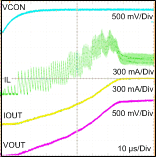ZHCS572H May 2011 – October 2023 LMZ10501
PRODUCTION DATA
- 1
- 1 特性
- 2 应用
- 3 说明
- 4 Revision History
- 5 Pin Configuration and Functions
- 6 Specifications
- 7 Detailed Description
- 8 Application and Implementation
- 9 Device and Documentation Support
- 10Mechanical, Packaging, and Orderable Information
7.3.2 Startup Behavior and Soft Start
The LMZ10501 features a current limit based soft start circuit in order to prevent large in-rush current and output overshoot as VOUT is ramping up. This is achieved by gradually increasing the PFET current limit threshold to the final operating value as the output voltage ramps during startup. The maximum allowed current in the inductor is stepped up in a staircase profile for a fixed number of switching periods in each step. Additionally, the switching frequency in the first step is set at 450kHz and is then increased for each of the following steps until it reaches 2MHz at the final step of current limiting. This current limiting behavior is illustrated in Figure 7-1 and allows for a smooth VOUT ramp up.
 Figure 7-1 Startup Behavior of Current Limit Based Softstart.
Figure 7-1 Startup Behavior of Current Limit Based Softstart.The soft start rate is also limited by the VCON ramp up rate. The VCON pin is discharged internally through a pull down device before startup occurs. This is done to deplete any residual charge on the VCON filter capacitor and allow the VCON voltage to ramp up from 0V when the part is started. The events that cause VCON discharge are thermal shutdown, UVLO, EN low, or output short circuit detection. The minimum recommended capacitance on VCON is 220pF and the maximum is 1nF. The duration of startup current limiting sequence takes approximately 75µs. After the sequence is completed, the feedback voltage is monitored for output short circuit events.